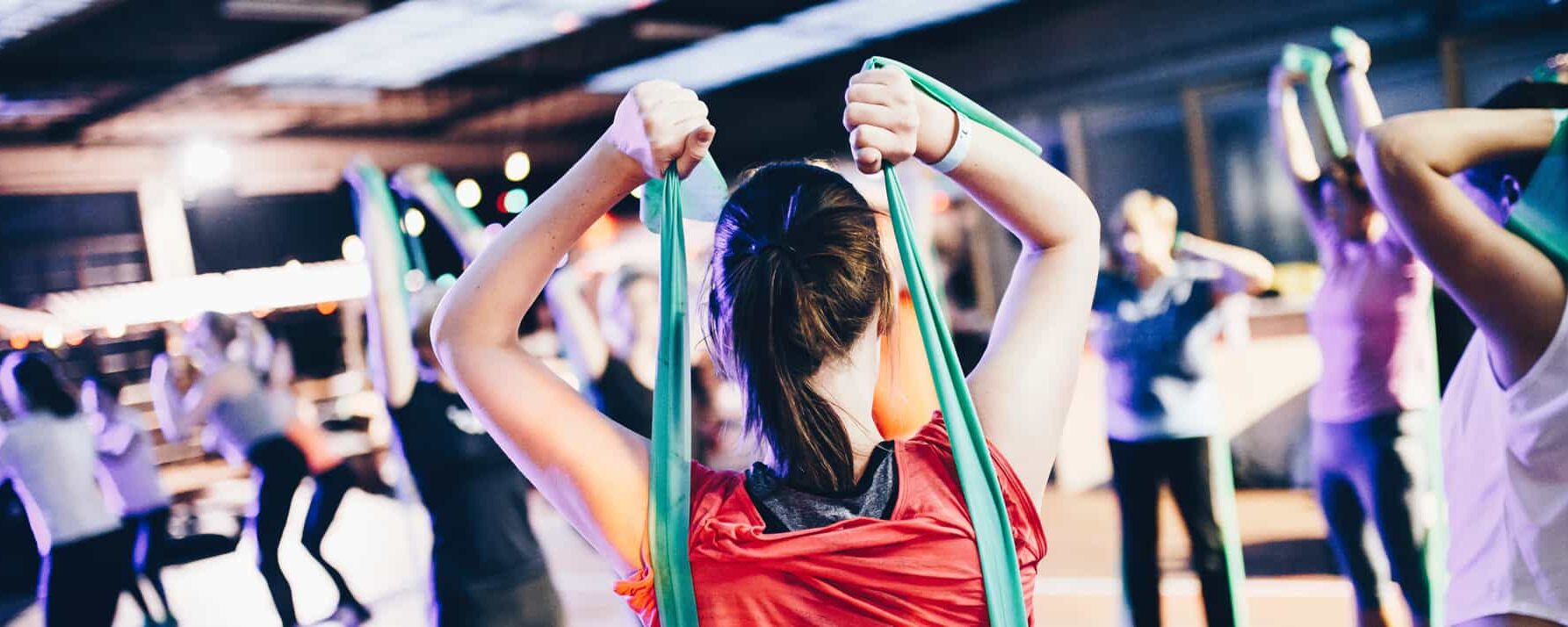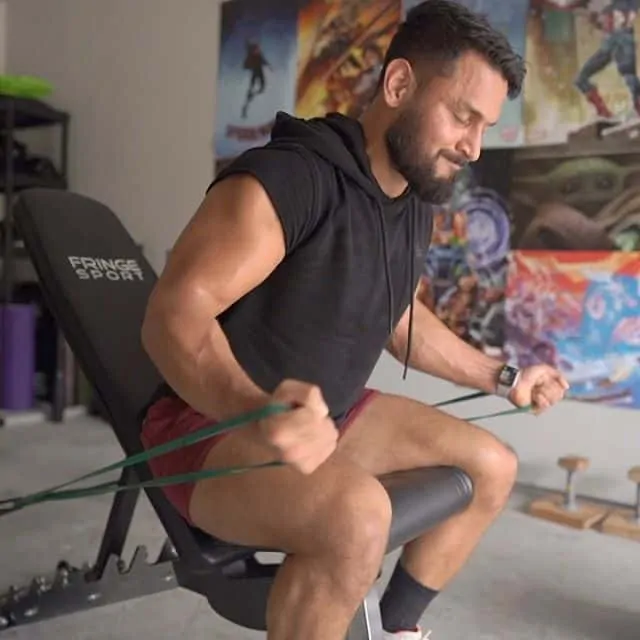
Resistance bands look all innocent and light, but let me tell you: resistance band workouts can be killer three times over.
To begin, they’re a great starting point for beginners, providing an almost injury-free way to venture into weight training.
Second: resistance bands offer an easy home workout option to keep your regular weight training going when you can’t get to the gym. (Even better, since resistance bands are so transportable , they’re also great to take on the road, in lieu of hitting a bite-size hotel gym.)
And finally, resistance bands are an awesome way to intensify your current routine that uses actual weights.

Resistance bands come in different thicknesses and different strengths. The thinner the band, the less resistance; the thicker the band, the more resistance. Because of their elasticity, which can vary between band size, type and manufacturer, you can find a band for any type of resistance, whether you are looking for high load / low volume or high volume / low load.
High load / low volume means you’re looking to move a lot of weight at less reps; high volume / low load means the opposite, moving less kilos but for longer rep sets. Resistance bands are loaded when they are lengthened to its furthest extent, which makes the exercise most difficult at the end range of the band. So, thick, heavy bands with high load will make for an intense strength training session. Take a thinner band and pound out as many reps as you can and you’ve got yourself an undeniable conditioning workout.
Regardless of the intensity at which you are strength training with your resistance bands, you are decreasing your risk of injury when compared to traditional weight workout. First, because overloading weight with bands is near impossible — if you don’t have the necessary strength, you won’t be able to stretch the band to its fullest extent. Further, resistance band exercises are static movements. Done correctly, you are isolating a muscle or muscle group, and therefore moving that singular muscle or muscle group with complete control and intention.
Speaking of isolating muscle groups, this is easy to do with resistance bands and therefore another key reason to strength train with bands. Anchor the bands to different surfaces and heights and at different angles forces different muscle groups to contract during the movement.
For example, loop the band around an overhead cable, wrap one hand around each end and work your triceps with pulldowns. Or, stand both heels in the middle of the band, hold one end of the band in each hand and take some biceps curls. Here’s the thing — these are basic exercises you can do for an entire upper body, for a full at-home workout. So for the physical rewards you can reap, these inexpensive bands are easily a no-brainer to have.
Bands are great for anyone — literally anyone, regardless of age, experience level or special population (ie. pregnancy) — looking to strength training safely. If balance is an issue, sit down and use the bands to get stronger. If load is an issue, use a lighter band to build strength as you can.
Physical Benefits of Resistance Band Workouts
Mobility
Resistance bands can build flexibility. Perform any basic stretch with a band, and you add just a bit of overpressure.
Strength
The strength perks of bands are endless. Getting to a gym is tough in our busy lives and bands can live or travel anywhere. Don’t have time for a big workout? Superset some band exercises, maybe one per joint for that perfect (and quick) full body workout.
Further, as a perk of any resistance band strength exercise, you will always be working your core muscles — hips, belly and low back. Controlling the release of the band’s tension requires you to buckle up through your core so that the band does not fire back toward the ground.
Rehab
Any injury can slow down our workouts as getting back on your feet or to full activity may take some time. Injuries also may require a renewed commitment to strength work to get you back to where you need to be. Bands can help you perform your strength work at home so you do not get stronger only while in your rehab session.
For you (the savage athlete, of course), you might be looking for some ideas to incorporate resistance bands into your strength training. A few great lifts to try resistance bands are:
Squats With Arms Overhead. This full-body exercise engages your legs muscles throughout the squat, the midsection to keep your body stable and your upper body to keep the band overhead.
Resistance Band Leg Extensions. Anchor a band to a fixed object by looping the band through itself. Run the cord remaining from the band under the bottom of a stool or chair. Take a seat on the chair, facing away from the fixed object, and place your feet through the loop, so the band is around the front of your ankles. You can move the seat further away from the fixed object, if you’d like to increase the intensity, AKA the resistance of the band. Sit tall, pull your belly in, and then extend your legs fully, so that your ankles, knees and hips are all in one line. You can flex or point your toes.
Band curls. Loop a band around a solid trunk and sit facing away from it on a chair or bench. Get far enough away to get some resistance even on the lower, and curl with both arms (the photo above illustrates this setup!).
Other Killer Band Exercise Examples:
Here are also a few I shared over on Instagram you can try:
Can you share which resistance bands you like to use?
Saad, thanks for reaching out to me! I use the Onnit bands, however I’m not too sure if they’re still selling them or not. If not I also have bands from Rogue that I use frequently and they’re great quality as well. I hope this helps and thanks for your support!
Great! A question though i saw you doing a double kettlebell shoulder press with a single band added resistance. Could you explain how you manage to get into the rack position with the band under your feet and in your hands ? I can’t find a proper way to do that without risking an injury. Thanks.